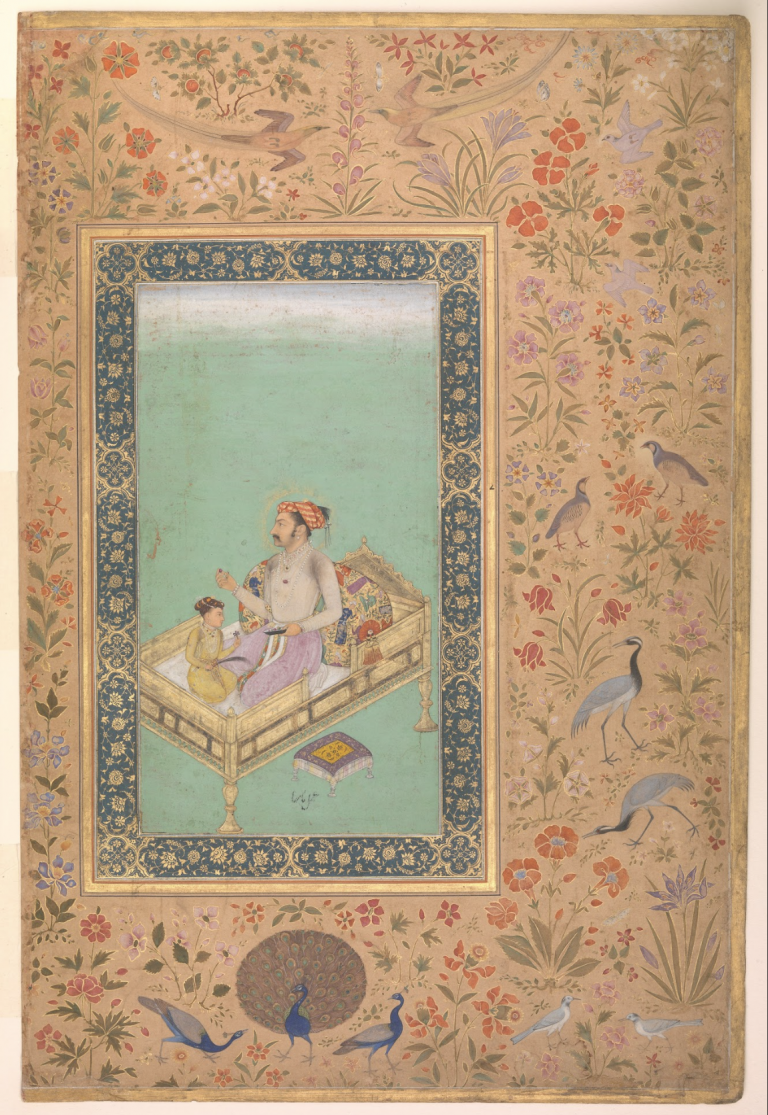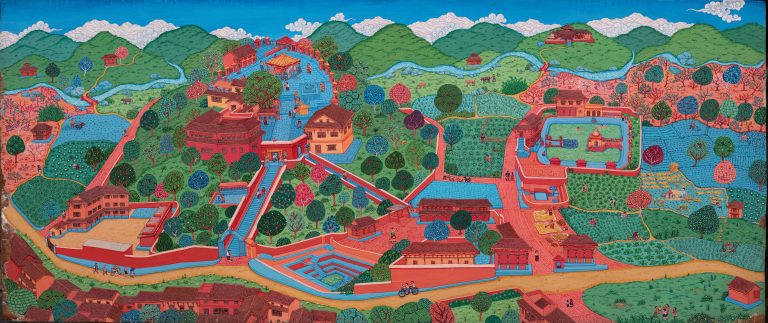Introduction Text by Madhu Jain
It is refreshingly educative to read art criticism that is almost half a century old. Richard Bartholomew’s catalogue essay in 1961 on Ram Kumar’s paintings reveals the extent to which the late critic puts himself into the picture. The essay almost reads like a letter to the painter—both in its rather personal tone and slightly rambling and self indulgent nature.
The art critic is obviously not afraid of expressing his subjective reaction to the Kumar’s canvases—of “what these paintings have said to me”. What I particularly admire about Bartholomew is the way he places the painter in context: he examines the evolution of both the artist and his oeuvre—and his state of mind.

Obviously, this piece is the result of many years of adda—of long conversations over cups of chai, etc. The essay shows Bartholomew’s intimacy with Kumar’s work, moods and thought process. How closely he has followed his work.
Praiseworthy as well is the blurring of boundaries between various disciplines. Bartholomew, a poet, photographer and painter as well, brings his knowledge of English literature to his critique. He is not afraid of letting the poet-in-him take precedence over the art critic, even if it may be stretching it a bit. For instance, while discussing Kumar’s style he writes: “A stripped style, paint in the nude, if I might essay a metaphor. These greys are quiet as nudes are quiet.”
Perhaps such art criticism, charming as it is, may appear a trifle anachronistic or quaint today. But it also shows up the arid nature of much current art criticism. Not only are large swaths of writing on art (particularly in India) these days dry and jargon-laden, much of is studded with references to art theorists and scholars.
It’s almost as if many of our critics are afraid of expressing their own views, hesitant to write about the feelings a particular work of art or artist may evoke. Sometimes you get the impression that the art critics are writing for each other.
It is time we not only read a work of art but also felt it—saw it with our own eyes so to speak.
Richard Bartholomew: Ram Kumar
Kunika Art Centre Exhibition, Catalogue, November 1961
Ram Kumar is now in Ranikhet, between pines, 6000 feet high, happy that he can paint in peace those landscapes of the mind. I do not know if he has his back to Banaras or his shoulder on the wheel of fortune which, he used to imagine, crushed humanity so cruelly. But there are some things that I know about him, if he is Ram Kumar. I know he is facing a canvas, or a book, or some quiet corner of himself. Or he must be writing, in that small, neat, feminine hand, letters to friends and literature for the public. If he is not doing any of these routine things he must be talking passionately but with that calm so characteristic of him. That is because he is sincere and serious. There are a hundred other things that he might be doing, of course. Things that we do. But with what consequence? A quiet man, a quiet painter, and a painter of the remembrance of things past, this is life for Ram Kumar.
Style is the man, and good style is simplicity in the interest of significance. Despite the complex themes of the paintings, the Ram Kumar style, I dare say, is simplicity itself. A great theme is nobly handled. There is maximum of articulation with the minimum of apparatus. A stripped style, paint in the nude, if I might essay a metaphor. These greys are quiet as nudes are quiet. They are virtuoso greys shot with green and blue and lemon-yellow. With a base of ochre or red sometimes.
The themes now are not people or mountains or streets or trees or rivers or mud banks. Large themes, the paintings are bird’s eye views of large tracts of nature. Things are seen from a height, and for a great distance. Hence, the element of mist and of mazes. Of much that is remembered and much that must be imagined. There are small calligraphic strokes, little dashes and dots of excitement, some triangles to lend thrust, some full and encrusted circles of isolation. A marked relief appears in these paintings. The people, as people, have disappeared – the streetwalkers, the embittered intellectuals, the clerks, the waiting, worried and watchful wives, and the crossed-eyed instigators of double-crossed lives.
Half of the old Ram Kumar has gone into retreat – the perplexed, prognosticating Ram, Peace-Council worker, the workers-of-the-world-unite man. The painter that was a kind of insurance man in aesthetics. Most of the slogans have gone, too. And the processes that materialise suffering. That was a phase which was jolly good while it lasted. It had, when Ram Kumar was not melodramatic, a kindly, tender pathos. It put the people in the front, and the landscape, or cityscape, in the background. The two were related, of course. But they had a kind of relationship actors have to the decor. The dramatic was Ram Kumar’s demon then. The muse is now lyrical and Ram Kumar muses gently, with melancholy, or nostalgia.
No, these people have not all gone away. They lurk behind the landscapes, under those drifts of feeling, unconscious figurations typical of the old constructions.
The old urge is sublimated and censored by the dream process, a creative process which promotes and pushes up these images.
What seas what shores what grey rocks and what islands What water lapping the bow, And scent of pine and the woodthrush singing through the fog, What images return, O my daughter.
II
Ram Kumar reminds me of poetry: his painting is poetry. It is natural that as writer and thinker, he should, from time to time, rediscover completely the world of poetry. As a poet, I know that poetry is the weapon of the completest surrender, even if this is a paradox. It is not what you give but what you get that makes forgetting so difficult. That applies to friendship. A personal demon rides me hard when I write about Ram. He has gone so far I have to catch up.
Handpicked from what I consider is Ram Kumar’s most fecund period, when early this year the post-Banaras mood of integration made him meander into “memory-painting”, this exhibition contains The Shore, a transitional piece. There is in this work a brown sandwich filling between the typical greys of texture and tone that he is to explore further and process. Abstract as stiller abstracts go, and yet rooted deeply in the total picture which is a landscape and not the representation of a scene, the painting is an epilogue to the Banaras period. There is, as I see it, no mystery of mood, no mixing of metaphors. The Shore is the prologue to the great Homage to the Waste Land, a painting heavily studded with all that is left when there are quick shifts of the tide in the mind, and after periodic flooding of the arena of observation. The Shore is an expansive view of a great calm. The Homage is a holy hangover of the import and impetus of Eliot’s Waste Land.
Virtues there are in this virtuoso work. It is emphatic, clear, controlled and splendid as craft. The technique of the spread is an extension of the “sandwich filling” in the earlier painting, separated really by two months. There is much that intrigues the eye for there are minor pictures, small subsidiary images like the unconscious figurations.
Anyone familiar with the text, context and symbolism of Eliot’s Waste Land will appreciate how much of the poem is relevantly used in the Homage. There are some parallels; the obvious literary ones are those that Eliot uses for the crescendo of his condensed epic, the import of the Upanishadic concepts Datta, dadyadham, damyata: Give, Control, Sympathise. Eliot also uses the principle of the Buddha’s Fire Sermon.
What has all this got to do with pure painting which is not illustrative? The post-Banaras period is a resolution of all that has been in the past two years. It places Banaras, the city of pilgrimage, the city of culture, and the city of music-makers in perspective. The memory mood has been given a local habitation and a name.
III
In a way I am talking through my hat for painting is painting, and literature is literature. But there can be poetry in painting and lyrical painting, of this quality, may, in rare moments, reach out to the sister arts. Not deliberately, but abstractly, as in the Homage. Like Shakespeare and the Bible, The Waste Land, I know, can be contextual to any human idea for it is big. The Homage, too, is big. It’s a landmark in Ram Kumar’s creative process. Impressive and memorable, if not entirely enchanting.
The softer, more positive paintings are the pure landscapes. There is Banaras II, probably the last of the Mohicans. That is a landscape by a master. An entire locale has been converted into the logic of paint. The logic of paint and the magic of paint, in the case of Ram Kumar, are one and the same. From the top you move down the temple-walk, to the left there is the withered tree with a memory-mirror reflection. A telegraph pole stands awkwardly near a bridge. The bridge passes over a canal and then there is a quick approach to the river-front, with those magnificent reflections.
How close all these paintings are in mood and style of delineation will become clear when we come to Landscape II. The same temple is moonlit and there is a spellbound atmosphere. The river-mist has crept up. Time, like the great floating, suspended moon, is still, this moment.
No more of paraphrase now. I have said what these paintings have said to me. The rest is etc.
NOTE: The images are not part of the above mentioned exhibition and is only used to illustrate the article.













